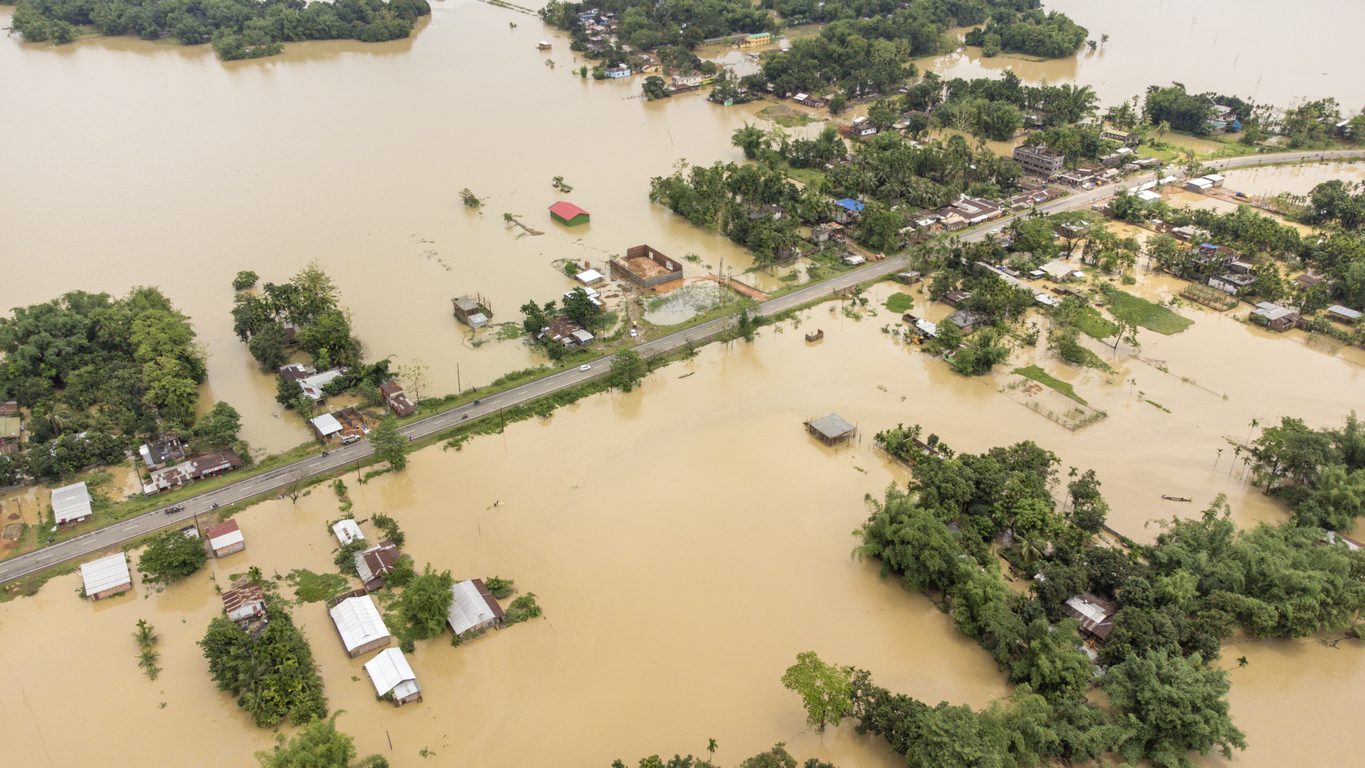In Warangal-Hanumakonda, Bhadrakali and Enumamula nalas, designed for 100 mm/hour, choked at 50 mm with plastic and encroachments.
Published Oct 30, 2025 | 11:14 AM ⚊ Updated Oct 30, 2025 | 11:14 AM

Roads built at Rs 28,000 crore under BRS now need Rs 1,000 crore repairs annually—monsoon after monsoon. Credit: iStock
Synopsis: Telangana drowned in 340 mm rains, submerging Warangal, Hanumakonda, and beyond—trains trapped, villages marooned, crops lost, damages exceeding Rs 5,000 crore. Despite IMD red alerts, no evacuations; delayed NDRF, crumbling tanks, choked nalas, and vanity projects like Musi Riverfront failed. Governance apathy, encroachments, and climate extremes demand urgent revival of Mission Kakatiya, SNDP, AI flood models, and accountable resilience.
The heavens opened and Telangana drowned in a single, merciless downpour—340 mm in Warangal’s Parvathagiri, 312 mm in Hanumakonda’s historic heart, 200–300 mm across Jangaon, Siddipet, Khammam, Mahabubnagar, and Nalgonda. Roads became rivers, villages islands, cities submerged.
Kazipet’s underbridge trapped trains in a lake; Bhadrakali Lake breached, flooding Warangal’s ancient temple and Hanumakonda’s bus stand. Colonies like Enumamula, Lashkar Singaram, and Kothawada turned into brown seas—cars floated, walls collapsed, a woman died beneath rubble.
Power vanished for 36 hours; networks failed. Rural mandals in Bhoopalpally, Mulugu, and Jayashankar were marooned; Munneru and Godavari tributaries erased homes.
Hyderabad’s Musi, still scarred from September, swallowed low-lying areas again. Over 50,000 hectares of kharif crops vanished; 1.2 lakh people lost shelter; damages soared past Rs 5,000 crore in 48 hours.
This was not an aberration. It was the culmination of a year of cascading failures—August’s Medak deluge, September’s MGBS submersion, now a statewide catastrophe.
The Indian Meteorological Department issued red alerts 48 hours ahead. Independent forecasters flagged “life-threatening” flash floods. Yet, no pre-emptive evacuations materialised. NDRF teams arrived late in Warangal, absent in Khammam’s worst-hit Palwancha.
Revenue Minister Ponguleti Srinivas Reddy’s “immediate measures” meant helicopters surveying after villages had spent nights on rooftops.
Chief Minister Revanth Reddy, touring Delhi, returned to announce ex-gratia—standard post-trauma theatre. The state’s Disaster Response Force, understaffed and under-equipped, managed optics, not outcomes.
Infrastructure crumbled under predictable strain. Telangana’s 62,000 tanks—once its monsoon insurance—have shrunk to 16,000 functional units.
Mission Kakatiya, BRS’s flagship, restored 27,000 by 2023 but stalled post-regime change; silt re-accumulates, gates rust. The Strategic Nala Development Programme (SNDP), which saved 175 Hyderabad colonies in Phase I, lies frozen at Phase II—Rs 667 crore sanctioned, zero disbursed, contractors vanished.
In Warangal-Hanumakonda, Bhadrakali and Enumamula nalas, designed for 100 mm/hour, choked at 50 mm with plastic and encroachments. Hyderabad lost 70 per cent of its 3,200 lakes to IT corridors and gated communities. Khammam’s Wyra and Paleru reservoirs released water without downstream alerts, amplifying rural flooding.
Urban planning is a cruel joke. The Rs 1.5 lakh crore Musi Riverfront Development—Congress’ vanity—prioritises 55 km of promenades, 1,000 acres of luxury real estate, and zero flood modelling.
Slum dwellers along the river face “rehabilitation” that smells of eviction; sudden releases from Himayatsagar and Osmansagar fuel conspiracy theories of engineered floods.
Roads built at Rs 28,000 crore under BRS now need Rs 1,000 crore repairs annually—monsoon after monsoon. Panchayats, un-elected since 2020, cannot clear a drain or fell a dying tree.
The Centre’s silence is deafening. Telangana’s Rs 16,732 crore relief memorandum gathers dust in North Block. NDRF norms demand state requests post-damage assessment; circular bureaucracy ensures aid arrives after elections, not evacuations.
Meanwhile, climate change loads the dice—monsoons 30–40 per cent heavier, cyclones stalling longer. But Telangana’s response is stuck in 1908, when the Musi flood killed 15,000 and birthed modern Hyderabad. No state-wide flood atlas, no real-time reservoir dashboard, no urban wetland policy.
Citizens are not blameless. Warangal’s affluent colonies encroach Bhadrakali buffer; Hyderabad’s techies dump Starbucks cups in storm drains. Farmers in Nalgonda rebuild homes on riverbeds, trusting “next year won’t be so bad.”
Daily wagers in Siddipet refuse relocation, citing lost livelihoods. Social media erupts—“Govt knew the cyclone was coming!”—yet voter turnout rewards the same parties. Apathy is bipartisan.
The human toll is visceral. In Khammam’s Kusumanchi, a mother lost her child to electrocution from a fallen line. Nalgonda’s Miryalaguda saw 200 hostels flooded; students slept on desks.
Warangal’s Enumamula market, underwater for three days, rotted Rs 10 crore in vegetables. Kamareddy farmers, insured under PMFBY, await claims while moneylenders circle. Elderly in Mulugu’s Venkatapuram died of snakebites in relief camps lacking medicine.
A reckoning is overdue. First, governance: conduct panchayat polls within 90 days; empower local bodies with flood funds. Second, infrastructure: revive Mission Kakatiya 2.0—target 10,000 critical tanks in 24 months, using MGNREGS labour.
Fully fund SNDP with citizen oversight committees. Third, technology: deploy AI flood models (piloted in Hyderabad) statewide; link reservoirs via SCADA for real-time releases.
Fourth, urbanism: enforce 50-metre lake buffers, retrofit drains for 150 mm/hour, tax encroachments retrospectively. Fifth, accountability: independent flood audits, public dashboards for relief expenditure, criminal liability for negligent releases.
Civil society must weaponise data—RTI floods, satellite imagery, crowd-sourced damage maps. Media must track the money: where did August’s Rs 500 crore go? Courts must fast-track PILs on lake encroachments. Political parties must be dragged from manifesto poetry to delivery prose.
Telangana’s tragedy is not rainfall. It is refusal—to plan, to enforce, to learn. The Deccan plateau, once irrigated by ingenuity, now irrigates despair. As the sun bakes the mud, the state must choose: rebuild the same vulnerabilities or reimagine resilience. The next cloudburst waits for no one.
(Views are personal)
